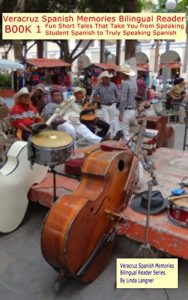It's fun. Most bilingual readers, although they are very good, aren't much fun to read. In my Veracruz Spanish Memories Series I've set out to change all that. The tales are short; the topics either warm your heart or bring a smile to your lips.
The Spanish is full and expressive. This isn't a book for beginners. It's great language development for intermediate and advanced students.
In our blog for our Spanish immersion school in Veracruz, Mexico, my husband wrote about little, human, usually happy, often touching things we'd see as we were out and about the city. These short writings (many with pictures) are the basis of my book. They were written in a delightful, respectful style.
The Spanish translations of these tales comes first. Each is written in Spanish that is equal in style to that of the English. You'll read Spanish the way a well-spoken native Spanish speaker would have written them.
You'll get to experience the difference between a "schoolish, textbookish" translation, which these are not, and a full and true to the intent and feeling handling that is encountered in the translation of literary novels.
To strengthen understanding and the educational value of the Spanish, there are lots of explanatory end notes.
You'll have lots of "Oh that's how they say that" moments. Seeing how things are really said in Spanish will go a long way toward taking you from speaking student Spanish to truly speaking Spanish.
The Spanish is full and expressive. This isn't a book for beginners. It's great language development for intermediate and advanced students.
In our blog for our Spanish immersion school in Veracruz, Mexico, my husband wrote about little, human, usually happy, often touching things we'd see as we were out and about the city. These short writings (many with pictures) are the basis of my book. They were written in a delightful, respectful style.
The Spanish translations of these tales comes first. Each is written in Spanish that is equal in style to that of the English. You'll read Spanish the way a well-spoken native Spanish speaker would have written them.
You'll get to experience the difference between a "schoolish, textbookish" translation, which these are not, and a full and true to the intent and feeling handling that is encountered in the translation of literary novels.
To strengthen understanding and the educational value of the Spanish, there are lots of explanatory end notes.
You'll have lots of "Oh that's how they say that" moments. Seeing how things are really said in Spanish will go a long way toward taking you from speaking student Spanish to truly speaking Spanish.












